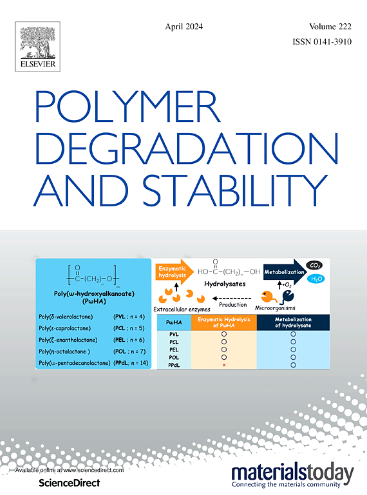利用先进的光谱技术重新研究含有 APP/季戊四醇/zeolite-4A的阻燃聚丙烯的膨胀机理
IF 6.3
2区 化学
Q1 POLYMER SCIENCE
引用次数: 0
摘要
聚磷酸铵(APP)和季戊四醇(PER)的混合物是一种非常高效的阻燃(FR)膨胀体系,适用于聚丙烯(PP)等聚烯烃。研究人员利用不同的光谱技术,包括连续波(CW)电子顺磁共振(EPR)光谱和固态核磁共振(NMR)技术,对这种聚合物中的阻燃体系的膨胀机理进行了研究。本研究重新探讨了含有和不含 4A 的 PP/APP/PER 配方的膨胀机理。使用 NMR、CW EPR 和脉冲 EPR 对膨胀体系进行了深入研究。CW EPR 技术证实,该体系在 250 至 350 °C 的膨胀过程中主要产生自由基。通过脉冲 EPR 和固态 NMR,证明了从以碳质残留物为主到以磷化残留物为主的关键结构转变。此外,还证明沸石 4A 在挤压 PP/APP/PER 配方时会完全塌陷,与 APP 发生反应生成铝磷酸盐。然后在 350 至 400 °C 之间生成硅磷酸盐。在高温条件下,铝磷酸盐和硅磷酸盐都有助于保护残留物中的芳香族结构。本文章由计算机程序翻译,如有差异,请以英文原文为准。
Re-examination of the intumescence mechanism of fire retarded PP with APP/pentaerythritol/zeolite-4A using advanced spectroscopic techniques
The mixture of ammonium polyphosphate (APP) and pentaerythritol (PER) is a very efficient flame retardant (FR) intumescent system suitable for polyolefins such as polypropylene (PP). The mechanisms of intumescence of this FR system in this polymer was investigated using different spectroscopic techniques including continuous wave (CW) electron paramagnetic resonance (EPR) spectroscopy and solid state nuclear magnetic resonance (NMR) technique. In this work, the intumescence mechanism of PP/APP/PER formulations with and without 4A is revisited. The intumescent system was in-depth investigated using NMR, CW EPR and pulsed EPR. The CW EPR technique confirmed that free radicals are mainly generated during the intumescence of the system between 250 and 350 °C. Thanks to the pulsed EPR and solid state NMR, it was evidenced that a key structural shift from a predominantly carbonaceous residue to a predominantly phosphorated residue. Besides, it was also evidenced that zeolite 4A totally collapses during extrusion of PP/APP/PER formulations reacting with APP to generate aluminophosphates. Then, silicophosphates are generated between 350 and 400 °C. Both alumino- and silicophosphates contribute to protect aromatic structures in the residue at high temperatures.
求助全文
通过发布文献求助,成功后即可免费获取论文全文。
去求助
来源期刊

Polymer Degradation and Stability
化学-高分子科学
CiteScore
10.10
自引率
10.20%
发文量
325
审稿时长
23 days
期刊介绍:
Polymer Degradation and Stability deals with the degradation reactions and their control which are a major preoccupation of practitioners of the many and diverse aspects of modern polymer technology.
Deteriorative reactions occur during processing, when polymers are subjected to heat, oxygen and mechanical stress, and during the useful life of the materials when oxygen and sunlight are the most important degradative agencies. In more specialised applications, degradation may be induced by high energy radiation, ozone, atmospheric pollutants, mechanical stress, biological action, hydrolysis and many other influences. The mechanisms of these reactions and stabilisation processes must be understood if the technology and application of polymers are to continue to advance. The reporting of investigations of this kind is therefore a major function of this journal.
However there are also new developments in polymer technology in which degradation processes find positive applications. For example, photodegradable plastics are now available, the recycling of polymeric products will become increasingly important, degradation and combustion studies are involved in the definition of the fire hazards which are associated with polymeric materials and the microelectronics industry is vitally dependent upon polymer degradation in the manufacture of its circuitry. Polymer properties may also be improved by processes like curing and grafting, the chemistry of which can be closely related to that which causes physical deterioration in other circumstances.
 求助内容:
求助内容: 应助结果提醒方式:
应助结果提醒方式:


